
Alfalfa, also called lucerne, is a perennial flowering plant in the legume family Fabaceae. It is cultivated as an important forage crop in many countries around the world. It is used for grazing, hay, and silage, as well as a green manure and cover crop. The name alfalfa is used in North America. The name lucerne is more commonly used in the United Kingdom, South Africa, Australia, and New Zealand. The plant superficially resembles clover, especially while young, when trifoliate leaves comprising round leaflets predominate. Later in maturity, leaflets are elongated. It has clusters of small purple flowers followed by fruits spiralled in two to three turns containing 10–20 seeds. Alfalfa is native to warmer temperate climates. It has been cultivated as livestock fodder since at least the era of the ancient Greeks and Romans.
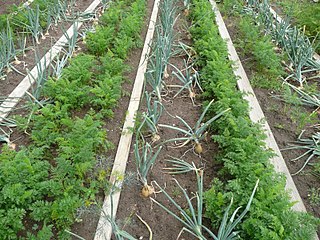
Companion planting in gardening and agriculture is the planting of different crops in proximity for any of a number of different reasons, including weed suppression, pest control, pollination, providing habitat for beneficial insects, maximizing use of space, and to otherwise increase crop productivity. Companion planting is a form of polyculture.

Hover flies, also called flower flies or syrphid flies, make up the insect family Syrphidae. As their common name suggests, they are often seen hovering or nectaring at flowers; the adults of many species feed mainly on nectar and pollen, while the larvae (maggots) eat a wide range of foods. In some species, the larvae are saprotrophs, eating decaying plant and animal matter in the soil or in ponds and streams. In other species, the larvae are insectivores and prey on aphids, thrips, and other plant-sucking insects.

Tragopogon porrifolius is a plant cultivated for its ornamental flower and edible root. It also grows wild in many places and is one of the most widely known species of the salsify genus, Tragopogon. It is commonly known as purple or common salsify, oyster plant, vegetable oyster, Jerusalem star, Jack go to bed, or simply salsify.

Verbascum thapsus, the great mullein, greater mullein or common mullein is a species of mullein native to Europe, northern Africa, and Asia, and introduced in the Americas and Australia.
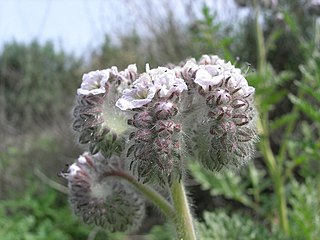
Phacelia cicutaria, with the common names caterpillar phacelia or caterpillar scorpionweed, is an annual species of Phacelia.

Insectary plants are those that attract insects. As such, beneficial insectary plants are intentionally introduced into an ecosystem to increase pollen and nectar resources required by the natural enemies of the harmful or unwanted insects pests. Beyond an effective natural control of pests, the beneficial insects also assist in pollination.

Platystemon is a monotypic genus of flowering plants in the poppy family containing the single species Platystemon californicus, which is known by the common name creamcups. It is native to Oregon, California, Arizona, Utah and Baja California, and is found in open grasslands and sandy soils below 6,000 feet (1,800 m) elevation.
Phacelia affinis is a species of flowering plant in the borage family, Boraginaceae, known by the common names limestone phacelia and purple-bell scorpionweed. It is native to the southwestern United States and Baja California and Sonora in Mexico. It can be found in scrub, woodland, forest, and other habitat.

Phacelia argentea is a rare species of phacelia known by the common names sand dune phacelia and silvery phacelia. It is native to the coastline of southwestern Oregon and far northwestern California, where it was counted at a total of 33 sites in 1995. It is the only phacelia species endemic to coastal sand dune habitat, an ecosystem which is altered and declining in the area.
Phacelia congdonii is a species of phacelia known by the common name Congdon's phacelia. It is endemic to California, where it grows in the Sierra Nevada foothills and the Transverse Ranges. It is a member of the flora in chaparral, woodland, and other local habitat.
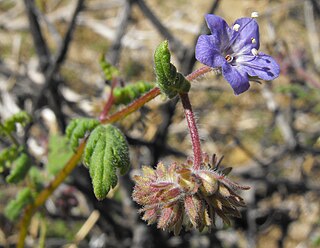
Phacelia distans is a species of flowering plant in the borage family, Boraginaceae, known by the common names distant phacelia and distant scorpionweed. It is native to the southwestern United States and northwestern Mexico, where it grows in many types of habitat, including forest, woodland, chaparral, grassland, and meadows.

Phacelia mutabilis is a species of flowering plant in the borage family known by the common name changeable phacelia. It is native to the western United States and Baja California, where it can be found in mountains and foothills, in forested and open habitat types, and deserts.

Phacelia neglecta is a species of flowering plant in the borage family, Boraginaceae. Its common names include alkali phacelia and neglected scorpionweed. It is native to the deserts of the southwestern United States in Nevada, Arizona, and southeastern California, where it grows in varied desert habitat, including areas with alkali soils. It is likely that its distribution extends into Baja California.

Phacelia nemoralis is a species of flowering plant in the borage family known by the common name shade phacelia. It is native to the west coast of the United States from Washington to central California, where it grows in moist, usually forested areas along the coastline and in the coastal mountain ranges.
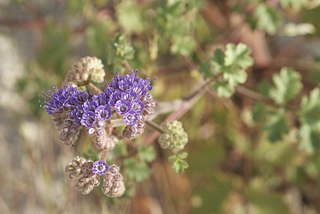
Phacelia pedicellata is a species of flowering plant in the borage family, Boraginaceae. Its common names include specter phacelia and pedicellate phacelia. It is native to the southwestern United States and Baja California, where it can be found in several types of habitat, including creosote bush scrub and Joshua tree woodland.
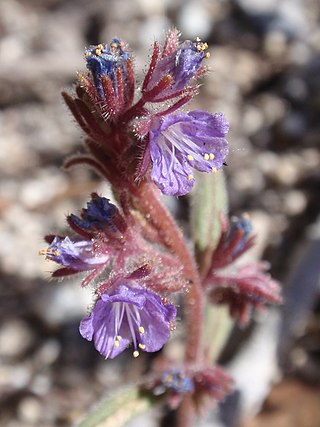
Phacelia quickii is a species of phacelia known by the common name Quick's phacelia.
Phacelia stebbinsii is an uncommon species of phacelia known by the common name Stebbins' phacelia.
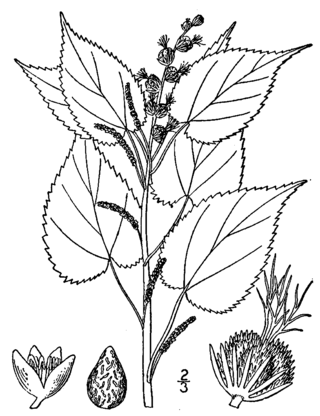
Acalypha ostryifolia, sometimes spelled ostryaefolia, is a plant in the family Euphorbiaceae and is commonly known as hophornbeam copperleaf, hornbeam copperleaf, or pineland threeseed mercury, is an annual herb of the copperleaf genus Acalypha. It is a native of North and Central America and is generally considered a weed.


















